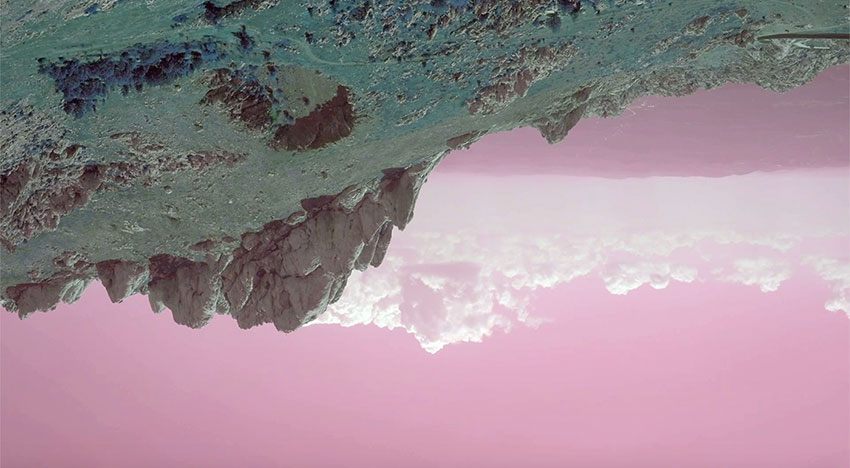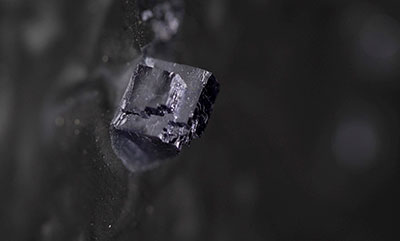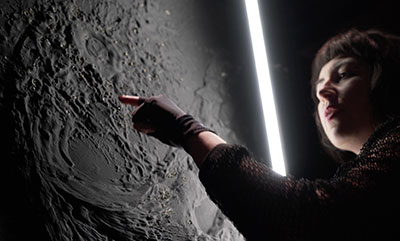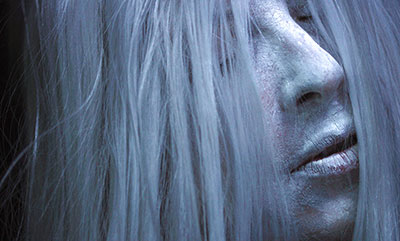Interview Laura Netz

Interdisciplinary artist MOON (Martina Zelenika) explores and creates art projects related to posthumanism, which focus on the rediscovery of fundamental ethical values in the coexisting environment, regain and train new skills. With a background in fine art and design, the main characteristic of MOON’s work is the symbiosis of traditional techniques and the latest digital technology and inspiration. Furthermore, MOON is interested in traditional and digital creative tools that relate to the inner alchemy of her body and the natural phenomenon that surround us.
Regarding the media and materiality, MOON would instead define her work as an archaeology, a concept defined by Zielinski and described as a process of investigating the things from the past much freer and much looser, and much less linear than we think.
The artist combines different media such as traditional drawing and collage, poetry, design, photography, relief, experimental video, installation art, interactive and new media art with an interest in image sonification, data sonification from brain waves, motion sensors and X-ray laboratory analyses of minerals, Augmented Reality (AR) technology, and mobile app. MOON is also a film director, a composer and a new media performer.
An example of her mixture of techniques there is the artistic project Meta Signal Sonar System or MSSS (2017) which tests out the modern communication space generating a visualisation of universal sound through the point of departure of analogue (traditional) drawing by using body movements.
Besides, the art project NEW EUROPE explores universal communication fields and makes a subtle impact on human awareness and individual self-recognition by absorbing a full image of the world we exist. The project also explores the sounds of mineral stones in the form of a sound, interactive installation. It is a data sonification from laboratory analysis.
The obtained laboratory analyses of mineral rocks were used for further computer processing into sound. The result: three different sounds transmitted from three different mineral stones. With a work also rooted in ancient and current philosophical currents, MOON address metaphysical aspects of our existence by the physical phenomena of our universe.




For those that are not familiar with your work, could you tell us a bit about your background and inspirations?
I belong to the generation born at the end of the 1970s in Ex-Yugoslavia, whose life has been marked by constant political, national, religious, economic and cultural tensions and conflicts still present today, witnessing the dark and the bright sides of human nature. During the war in Croatia from 1991-1995, I was lucky to have a PC. Right from the beginning, I used the computer as a tool for creating something new and I was never interested in playing video games like my peers at that time. I still apply the same approach of using technology experimentally for creative purposes. The symbiosis of traditional techniques and the latest modern digital technology is one of the main characteristics of my work.
Today when Croatia is a member of the EU but still considered a Third World country, when a massive ecocide of the Earth’s paradise is culminating and the future that awaits us is speculative, my inner force and the purpose as an artist are stronger than ever before. Yet as an artist I do not engage directly into politics as many artists in Croatia nor do I tackle topics related to the old regime, local authorities or everyday politics.
I observe, I ask questions and focus on the roots of all problems that lie in the human race, closely related to a belief system and individual’s existential nucleus (soul), subtly helping them to gain awareness about the World in which we live. My main fields of interests are cosmology, universality, eco-philosophy, and language. Universe, vibrations, energy, all the life forms of complex designs of this Planet, fascinate me and provide a constant source of inspiration.
Global ecological questions are reflected in my recent art film Mountain (presenting the soul of a mountain, 2019) and a fashion brand Druid (fashion with eco-philosophy, advocating for endangered species, 2011). My aim as the artist and a member of global society is to make others aware of their existence, give them a wide image of What we are in our profoundly human foundation and influence on individual self-recognition.
Advocating freedom and health of human beings (roots of all problems) in all aspects of society, my art positively influences the World’s frequency. I invite my audience to take two or three moments, step back a little more, take a deep breath and relax. You see, it’s working already.
Recently, theories of posthumanism have become very important, primarily through the work of Rosi Braidotti. Can you describe what is for you posthumanism? How would you define it?
According to Rosi Braidotti, there are three different types of post-humanism: a liberal approach, an interdisciplinary approach and a critical post-humanist approach that she defends, which is very close to my statement and belief system. First of all, let’s define the term “human” and what it means to be human today. As we live in 2020 and are still occupied by a patriarchal system, in the world where men are those who consider themselves as bigger humans than women – who are seen as a less worthy extension of men, we cannot ignore all the consequences of this belief system and the impact of the 3rd and 4th industrial revolution on the environment.
We are witnessing changes such as the rise of ecofeminist movements globally where the female position is identified with devastation, exploitation, and suffering of the natural world caused by male domination. Even though biological, psychological and genetic changes caused by environmental disbalances are visible both on women and men, women are the first to become aware of these changes.
Today we are stepping through the hard labour of dualisms of animate/inanimate, nature/culture, human/non-human, the duality of human identity and duality of technology. Millennials as the most affected population are struggling with addiction to tech devices, games and social networks.
We already have a generation whose fundamental human capacities and virtues, such as self-will, persistence, responsibility, emotional intelligence and capability of making deep connections with others, empathy, self-esteem, are impaired, and it is not their fault. Responsibility comes from their parents and the industrial-economic-scientific-educational system.
The responsibility of individuals and the entire scientific-economic industry is to test each new product under strict measures and adapt it to the conditions of the environment and the need of the human society, thus respecting the ecosystem and everyone’s’ right to a healthy life. In addition, the freedom and safeties of the individual, as for collective society are at the highest risk.
We have a generation that is growing up in an illusory sense of freedom. They will never experience the freedom without global control, the sense of privacy that I or my parents had while they were young. We are not ready for any upcoming new tech jumps if we look from this perspective, as the mess should be cleaned up first. These are scary facts of our lifetime.
In line with today’s industry trends and future predictions, creativity is gaining in popularity across all industries and it will be one of the most sought-after skills, especially in science. As technology evolves rapidly in the Anthropocene era, in the chaos of panic and excitement, the evolution of consciousness comes naturally.
Posthumanism theories do not centralize human species, on the contrary, they highlight ancient or universal spiritual (not religious) traditions with a tendency to equality. Post-humanism should pragmatically focus on the rediscovery of fundamental ethical values in the coexisting environment, regain and train new skills following the principles of well-being for all beings/appearances that coexist on the Planet.
As posthumanism is linked to new-materialism, I see a transition gap in prediction, hoping that neo-humanism will rise much earlier than expected. From my point of view, post-humanism is a contemporary postulate of life, which highlights spiritual practice to enhance the physical, mental, and spiritual well-being that indirectly benefits society through social and economic service.
I believe that we can build a better global coexistence that will embody cultural values such as generosity, tenderness, and care, and engage with our world more profoundly as planetary patriots. We have to focus on NOW by leaving the future on solid ground for the next generations to come.
Another aspect of your work is about alchemy. Is this related to media archaeology? Which is your relation with materials and technology?
The term alchemy can easily fit as an influential practice that I use in my artistic work and experimentation. In addition to the use of a fusion of old/new media or traditional/modern materials, a handmade drawing is the most important medium in my artistic practice. Through it, the expression of the body and emotions, intellect, intuition and imagination unite into an empirical dimension that then releases the inner creation of meta-perception.
My art production starts with meditating and achieving transcendent experiences, testing my own limits. In realization, I combine different tools and media, deconstructing layers while expressing sensations as visions and making new values. I believe that my approach of using old and new materials, exploring ancient knowledge and theory, contemporary philosophy, quantum mechanics, and alternative methods through which I reach new conclusions would be better described by the term anarchaeology of Zielinski rather than media archaeology.
As Zielinski defined, anarchaeology implies that things that we are investigating from the past are much freer and much looser, and much less linear than we think. As Dr Penesta Dika has described in her review of my last solo exhibition “Art and Science expressed in Lines: Extended realities” in Vienna, October 2019, lines in my artworks besides representing tones or notes, also express the connections between the real and the virtual world, connections between past and present, between technological and traditional art, connections between our world and the universe, between seeable and unseeable things, between consciousness and unconsciousness.
I present those lines in combination with technology to create trans-lines, trans-surfaces, trans-spaces that are inside of us, or that surround us.
It seems from your work with different media that you are a very prolific artist. Can you explain to us which are the benefits of using such diverse media? And in detail, can you elaborate more on your work with minerals?
Another feature implemented in my work ethic is an experimental approach that is naturally driven by my curious nature. It’s important to give oneself the freedom of expression, which includes exploration of a variety of media and tools that can help expand creativity, increase possibilities, test one’s limitations and raise awareness. Following the idea and vision, I surrender to new challenges fearlessly.
I enjoy the preparatory phase and exploring technical possibilities, trying to find the best tools for the desired result. During the journey, unforeseen occurrences and unpredictable impacts are welcome and allowed, as they can lead to new discoveries. Benefits of being able to work with such diverse media increase possibilities for success. This possibility influences one’s way of thinking and allows for creative ways of solving problems.
Concerning my multi-layered art projects and artworks, besides being a creator, I also consider myself as a project manager and a producer. While I mostly create alone and work independently, some of my projects included collaborations with digital developers, electric engineers, professional musicians, and even the Research Institute Ruđer Bošković.
The creative approach used in the project NEW EUROPE (2016-2017), the artwork with minerals, is a fusion of imagination, intuition, and facts, combined with laboratory analyses and scientific methods, resulting in an artistic-scientific or poetic-scientific outcome. The project reflects the state of human evolution (as well as my evolution), and represents the phenomenon of dark matter, expressed audibly and the phenomenon of change represented visually.
Handmade reliefs reflect the visualizations of the impact of the phenomenon of change presented as an organic-geomorphic surface in three artworks, made of concrete gypsum with additional reinforcement on impregnated MDF panels. Reliefs are originals/unique, variable weights from 25-30 kg, framed with aluminium profiles. The diptych, New Europe shows impacts on Earth from the outside, such as craters formed by meteorites crashing on our planet, representing external depression. The surface of the relief is covered with dust and small pieces of gold pyrite mineral stone.
The gold pyrite FeS2 (fake gold, gold for fools) is technically known as iron sulfide and is one of the most common sulfide minerals, recently used for developing solar “energy bandgap” – essential for making solar cells or semiconductor devices. A second one is a diptych, Whip of God represents the tectonic changes of Earth, an internal change. Its surface is covered with dust and small pieces of silver galena mineral stone.
The silver galena PbS is a cubic stone made of lead minerals. It has been mined for thousands of years due to its lead and silver content. The last one, the triptych Rebirth of the Earth reflects three different types of surfaces caused by inner or external physical influences. Its surface is covered with dust and small pieces of black sphalerite mineral stone. The black sphalerite ZnS is a mineral that consists largely of zinc sulfide in crystalline form, but it almost always contains variable amounts of iron.
It has been known since ancient times that the healing aspects of mineral stones have been associated with energy vibrations and have been used to balance energy centres in the human body. Believe it or not, it’s up to you. In further developing the New Europe project, I explored potential options for laboratory analysis and concluded the X-ray would fit perfectly to analyze additional physical properties of mineral stones.
I arranged a collaboration with scientific advisers from the Department of materials physics, Laboratory for molecular physics and synthesis of new materials at the Ruđer Bošković Institute in Zagreb Croatia, which provided two types of quantum mechanics: a high-resolution scanning electron microscope FESEM and (XRPD) x-ray powder diffraction which deals with particle analysis, determination of chemical and crystallographic properties.
Considering the large amount of data obtained from laboratory analyzes, I only used 1⁄4 of data for each mineral. I then converted the data to audio readings through two different digital tools, thus contributing to the advancement of scientific knowledge. One is the software Photo Sounder that produces sound from the image, and the other is Music Algorithms.
The difference is based on the preparation approach of files, types of translation, and results. Mixing two different audio outcomes from the same mineral stone, the deep frequency sound and the piano version resulted in an almost meditative effect of relatively harmonious and abstract music. The result is improvisational music in which all elements of the composition are almost left to chance, except for the influence of algorithmic composition technique that contributes to the rhythm and tempo.
New Europe is a sustainable, multisensory piece of art that can simultaneously be enjoyed as a relief painting, an audio file, and an energy source. It provides the viewer with a complete experience, including 4 senses: visual, touchable, audible and energetic.
You also work on deconstructing sound. Can you explain to us which is the primary function of the work Meta Signal Sonar System (2017)?
As Umberto Eco has defined in his book “The search for the perfect language”, 1972: “The dream for the perfect language has always been invoked as a solution to religious or political strife, or just simple difficulties in commercial exchange.” Meta_Siganl Sonar System, MSSS for short, is an artistic research cycle (2017- 2020), which reflects my need for the search of the perfect language, translated as semiotic decoding of universal sound into an analogue (handmade) drawing made of layers of elliptical lines.
It is an exploration of metapsychology and my open system – the body. The main media that is used in this process is energy/vibe considered as a language without limitation, consciously negating the boundaries of our languages, which naturally represent the limits of our knowledge. By contemplating ancient and contemporary philosophy, and my thinking, I explore universal communication fields or media, such as vibration/ energy/ body language/ sixth sense/ intuition.
As energy/ vibe produces sound, it can be considered as a primary communication tool for expression – a blueprint. By using a meditative approach, through breathing practice, ancient Stoic meditation technique and AUM mantra meditation technique, I investigate and reach out to a human meta-perception. The results of this process are visual soundscape compositions or poetically called “sound galaxies” as a reflection of emotions and the mind on surroundings including noise and lo-fi soundscapes.
During the process of intuitive (meditative) drawing, I use unlimited semiosis and semantic approach which gives the same result – motifs free from strictly defined meaning. It gives a different visual mark every time I stand in front of a blank paper: starting from the wrist movements, elliptic and circular movements from the elbow to the movement of the whole body. For making life-size drawings, body conditions and motor skills are emphasised.
As the elliptic orbit is universal, shapes and lines together form a so-called attractor, which in physics and math is a state or behaviour toward which a (nonlinear) dynamic system tends to evolve. In my work can be found from single-point attractor to variation of complex or strange attractor based on Jung’s theory of chaos.
The process of preparation of my emotional field is taking its place every time before I start to draw or produce creation with lines. It requires high concentration, focusing and achieving a positive emotional attractor (R. E. Boyatzis, K. Rochford and S.N. Taylor, 2015), waiting for the expansion of my energy in which the vision appears intuitively. It could be considered as art with healing benefits for others.
The cycle Meta_Siganl Sonar System (MSSS) consists of 8 original/unique body-size drawings made with a pallet of graphite pencils on canvas roll; 6th SENSE (2018, logograms of our ancestors), an audiovisual interactive collage combined with Augmented Reality mobile application MSSS and 10 handmade original/unique drawing-collages, in which I use image sonification technique; RECEPTILIUM (2018), a hi-tech audio-visual interactive drawing performance where brainwaves and motion data from my both hands are converted into sound and connected to generative animation.
And the latest art project is ChORUS (2019-2020), a generative audio-light installation that converts real-time data of Earth’s magnetic field into sound in real-time. Its’ production is financially supported by the Croatian Ministry of Culture, and the installation is currently undergoing a testing process.
La Petite Mort is an installation that works with Augmented Reality mobile apps. Can you express your opinion about these technologies? How they benefit users’ interaction and sound integration?
Augmented Reality technology fits into my artistic concept of sublimating different realities and mixing of perceptions in real-time. The artwork La Petite Mort (2019), as well as 6th SENSE (2018), are based on the technology of Augmented Reality and technically developed in collaboration with DitDot studio in Zagreb. Besides the apps that are developed in Unity 3D and specially made for each artwork, visually, both presented artworks consist of lines.
AR technology is a practical and effective digital tool. In addition to 3D animations, it can expand sonically too, which is implemented in my first AR app MSSS (Meta_Siganl Sonar System) of the project 6th SENSE (2018). Handmade artworks of the 6th SENSE were made differently from the La Petite Mort, which affects the way of scanning its tracking points. MSSS application reads specially designed plexiglass markers placed on the wall around framed artworks and provides a fluid 3D animation in space that appears in sync with integrated sounds.
As the 6th SENSE consists of ten artworks divided into three series (gold, silver, and black-gold sonar), people can experience ten different animated visual effects, including different sounds. The AR benefits the users as it allows them to physically participate in the representation of the artwork. Moving their bodies and the devices back and front, up and down, left and right, directly and subtly influencing the sound effects while observing the 360-degree animation, they become affected hypnotically.
I suggest to the visitors to dance with the tablet in their hands while managing their motor skills and focusing on the position of markers. It’s fantastic and interesting to see how users behave differently. AR app MoTHA (Metaprogramming of The Human Algorithm), is a digital extension of the triptych La Petite Mort (2019), life-sized drawings, which are seen as still sequences coming to life.
The app’s interaction concept acts as a touch screen interface through which users activate and perform 3D animated visuals with their fingers. Each artwork has differently animated visuals and effects. The app reads animation directly from the handmade drawings, seen as a 360-degree object in space, approximately 10 m apart or 1 m close.
Further development of the application is the implementation of sonic files that would be in sync with 3D animation. Animated coded visuals in both artworks gives an impression of an entity or energy from real-world objects. The purpose is to give viewers a multidimensional experience with classic viewing of handmade artworks.
Your work is defined as using evolutionary algorithms and genetic algorithms. Can you precisely define genetic algorithms in relation to your work?
In summer 2019, after discussing the topic of my new cycle Metaprogramming of the Human Algorithm and the artwork La Petite Mort with Dr. Penesta Dika, she came out with a clear definition which I’m going to use for this answer. My studies for artworks point out to the kind of optimization that emerges during the process of artistic creation.
These thoughts that are inspired by the so-called evolutionary algorithms, or genetic algorithms, include the process of the “survival of the fittest” in the aspect of matches between the human spirit and its genetic-based physical conditions. Since the main aim of my work is to bring humanity and the artistic creation process to its highest levels, optimization is necessary while selecting, creating, modifying and correcting analogue and digital drawings to create an AR – extension or any other extension included in my work.
What is your chief enemy of creativity?
Not having time for myself, not having a forest or a large park in the vicinity where I can go when I need to turn me into a hungry wolf. I often need to filter the body and the mind, to set basic preconditions for new excitements.
You couldn’t live without…
Except for the fresh clean air and water (food is overrated), music and resin incense are on top.





